Tobacco etch virus protein P1 traffics to the nucleolus and associates with the host 60S ribosomal subunits during infection
- PMID: 24991017
- PMCID: PMC4178839
- DOI: 10.1128/JVI.00928-14
Tobacco etch virus protein P1 traffics to the nucleolus and associates with the host 60S ribosomal subunits during infection
Abstract
The genus Potyvirus comprises a large group of positive-strand RNA plant viruses whose genome encodes a large polyprotein processed by three viral proteinases. P1 protein, the most amino-terminal product of the polyprotein, is an accessory factor stimulating viral genome amplification whose role during infection is not well understood. We infected plants with Tobacco etch virus (TEV; genus Potyvirus) clones in which P1 was tagged with a fluorescent protein to track its expression and subcellular localization or with an affinity tag to identify host proteins involved in complexes in which P1 also takes part during infection. Our results showed that TEV P1 exclusively accumulates in infected cells at an early stage of infection and that the protein displays a dynamic subcellular localization, trafficking in and out of the nucleus and nucleolus during infection. Inside the nucleolus, P1 particularly targets the dense granular component. Consistently, we found functional nucleolar localization and nuclear export signals in TEV P1 sequence. Our results also indicated that TEV P1 physically interacts with the host 80S cytoplasmic ribosomes and specifically binds to the 60S ribosomal subunits during infection. In vitro translation assays of reporter proteins suggested that TEV P1 stimulates protein translation, particularly when driven from the TEV internal ribosome entry site. These in vitro assays also suggested that TEV helper-component proteinase (HC-Pro) inhibits protein translation. Based on these findings, we propose that TEV P1 stimulates translation of viral proteins in infected cells.
Importance: In this work, we researched the role during infection of tobacco etch virus P1 protease. P1 is the most mysterious protein of potyviruses, a relevant group of RNA viruses infecting plants. Our experiments showed that the viral P1 protein exclusively accumulates in infected cells at an early stage of infection and moves in and out of the nucleus of infected cells, particularly targeting the nucleolus. Our experiments also showed that P1 protein binds host ribosomes during infection. Based on these findings and other in vitro experiments we propose that P1 protein stimulates translation of viral proteins during infection.
Copyright © 2014, American Society for Microbiology. All Rights Reserved.
Figures

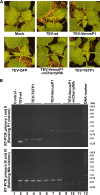
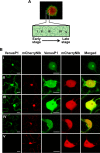

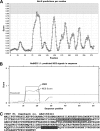

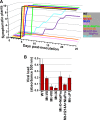
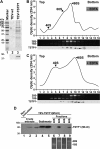

Similar articles
-
Interaction network of tobacco etch potyvirus NIa protein with the host proteome during infection.BMC Genomics. 2016 Feb 1;17:87. doi: 10.1186/s12864-016-2394-y. BMC Genomics. 2016. PMID: 26830344 Free PMC article.
-
Relocation of the NIb gene in the tobacco etch potyvirus genome.J Virol. 2014 Apr;88(8):4586-90. doi: 10.1128/JVI.03336-13. Epub 2014 Jan 22. J Virol. 2014. PMID: 24453370 Free PMC article.
-
Immunocytology shows the presence of tobacco etch virus P3 protein in nuclear inclusions.J Struct Biol. 1997 Apr;118(3):243-7. doi: 10.1006/jsbi.1997.3856. J Struct Biol. 1997. PMID: 9169234
-
Involvement of the plant nucleolus in virus and viroid infections: parallels with animal pathosystems.Adv Virus Res. 2010;77:119-58. doi: 10.1016/B978-0-12-385034-8.00005-3. Adv Virus Res. 2010. PMID: 20951872 Free PMC article. Review.
-
The Molecular Maze of Potyviral and Host Protein Interactions.Annu Rev Virol. 2024 Sep;11(1):147-170. doi: 10.1146/annurev-virology-100422-034124. Epub 2024 Aug 30. Annu Rev Virol. 2024. PMID: 38848589 Review.
Cited by
-
Abscisic Acid Connects Phytohormone Signaling with RNA Metabolic Pathways and Promotes an Antiviral Response that Is Evaded by a Self-Controlled RNA Virus.Plant Commun. 2020 Sep 14;1(5):100099. doi: 10.1016/j.xplc.2020.100099. Epub 2020 Jul 7. Plant Commun. 2020. PMID: 32984814 Free PMC article.
-
A Newly Identified Virus in the Family Potyviridae Encodes Two Leader Cysteine Proteases in Tandem That Evolved Contrasting RNA Silencing Suppression Functions.J Virol. 2020 Dec 9;95(1):e01414-20. doi: 10.1128/JVI.01414-20. Print 2020 Dec 9. J Virol. 2020. PMID: 33055249 Free PMC article.
-
Proteomic Changes during MCMV Infection Revealed by iTRAQ Quantitative Proteomic Analysis in Maize.Int J Mol Sci. 2019 Dec 19;21(1):35. doi: 10.3390/ijms21010035. Int J Mol Sci. 2019. PMID: 31861651 Free PMC article.
-
Replacement of P1 of soybean mosaic virus with P1 of clover yellow vein virus has no impact on virus viability and host specificity.Arch Virol. 2024 Jun 12;169(7):143. doi: 10.1007/s00705-024-06071-x. Arch Virol. 2024. PMID: 38864946
-
Sumoylation of Turnip mosaic virus RNA Polymerase Promotes Viral Infection by Counteracting the Host NPR1-Mediated Immune Response.Plant Cell. 2017 Mar;29(3):508-525. doi: 10.1105/tpc.16.00774. Epub 2017 Feb 21. Plant Cell. 2017. PMID: 28223439 Free PMC article.
References
Publication types
MeSH terms
Substances
LinkOut - more resources
Full Text Sources
Other Literature Sources

